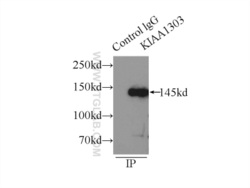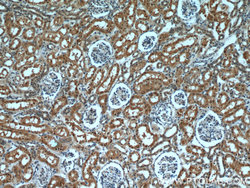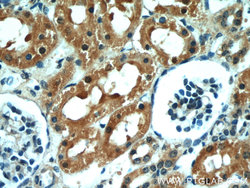Antibody data
- Antibody Data
- Antigen structure
- References [41]
- Comments [0]
- Validations
- Western blot [1]
- Immunoprecipitation [1]
- Immunohistochemistry [2]
Submit
Validation data
Reference
Comment
Report error
- Product number
- 20984-1-AP - Provider product page

- Provider
- Proteintech Group
- Proper citation
- Proteintech Cat#20984-1-AP, RRID:AB_11182390
- Product name
- Raptor antibody
- Antibody type
- Polyclonal
- Description
- KD/KO validated Raptor antibody (Cat. #20984-1-AP) is a rabbit polyclonal antibody that shows reactivity with human, mouse and has been validated for the following applications: IF, IHC, IP, WB, ELISA.
- Reactivity
- Human, Mouse
- Host
- Rabbit
- Conjugate
- Unconjugated
- Isotype
- IgG
- Vial size
- 20ul, 150ul
Submitted references BMP9 induces osteogenic differentiation through up-regulating LGR4 via the mTORC1/Stat3 pathway in mesenchymal stem cells.
High-throughput tagging of endogenous loci for rapid characterization of protein function.
Forchlorfenuron-Induced Mitochondrial Respiration Inhibition and Metabolic Shifts in Endometrial Cancer.
FARSB Facilitates Hepatocellular Carcinoma Progression by Activating the mTORC1 Signaling Pathway.
Arsenic interferes with spermatogenesis involving Rictor/mTORC2-mediated blood-testis barrier disruption in mice.
TBK1 Knockdown Alleviates Axonal Transport Deficits in Retinal Ganglion Cells Via mTORC1 Activation in a Retinal Damage Mouse Model.
Tetrathiomolybdate Decreases the Expression of Alkaline Phosphatase in Dermal Papilla Cells by Increasing Mitochondrial ROS Production.
Interleukin 6 promotes BMP9-induced osteoblastic differentiation through Stat3/mTORC1 in mouse embryonic fibroblasts.
A cleaved METTL3 potentiates the METTL3-WTAP interaction and breast cancer progression.
p63 Directs Subtype-Specific Gene Expression in HPV+ Head and Neck Squamous Cell Carcinoma.
A Rag GTPase dimer code defines the regulation of mTORC1 by amino acids.
Complement C1q binding protein regulates T cells' mitochondrial fitness to affect their survival, proliferation, and anti-tumor immune function.
N(7)-methylguanosine tRNA modification promotes esophageal squamous cell carcinoma tumorigenesis via the RPTOR/ULK1/autophagy axis.
NUMB facilitates autophagy initiation through targeting SCF(β-TrCP2) complex.
Spiropachysine A suppresses hepatocellular carcinoma proliferation by inducing methuosis in vitro and in vivo.
Effects of Bisphenol A on reproductive toxicity and gut microbiota dysbiosis in male rats.
Effect of resistance training on satellite cells in old mice - a transcriptome study : implications for sarcopenia.
Inhibition of ASGR1 decreases lipid levels by promoting cholesterol excretion.
The Deubiquitinase USP39 Promotes ESCC Tumorigenesis Through Pre-mRNA Splicing of the mTORC2 Component Rictor.
CARS senses cysteine deprivation to activate AMPK for cell survival.
Exposure to DEHP induces testis toxicity and injury through the ROS/mTOR/NLRP3 signaling pathway in immature rats.
CD82 protects against glaucomatous axonal transport deficits via mTORC1 activation in mice.
mTOR Promotes Tissue Factor Expression and Activity in EGFR-Mutant Cancer.
A glycolytic shift in Schwann cells supports injured axons.
Location-specific inhibition of Akt reveals regulation of mTORC1 activity in the nucleus.
Uptake of collagen type I via macropinocytosis cause mTOR activation and anti-cancer drug resistance.
TXNIP deficiency mitigates podocyte apoptosis via restraining the activation of mTOR or p38 MAPK signaling in diabetic nephropathy.
Acetyl-CoA Derived from Hepatic Peroxisomal β-Oxidation Inhibits Autophagy and Promotes Steatosis via mTORC1 Activation.
Thioredoxin-interacting protein deficiency alleviates phenotypic alterations of podocytes via inhibition of mTOR activation in diabetic nephropathy.
Quantitative proteomics reveal the alterations in the spinal cord after myocardial ischemia‑reperfusion injury in rats.
The HGF-MET axis coordinates liver cancer metabolism and autophagy for chemotherapeutic resistance.
NOX1-Dependent mTORC1 Activation via S100A9 Oxidation in Cancer Stem-like Cells Leads to Colon Cancer Progression.
mTOR-S6K1 pathway mediates cytoophidium assembly.
The Functional Proximal Proteome of Oncogenic Ras Includes mTORC2.
UNBS5162 inhibits proliferation of human melanoma cells by inducing apoptosis via the PI3K/Akt pathway.
Golgi phosphoprotein 3 (GOLPH3) promotes hepatocellular carcinoma progression by activating mTOR signaling pathway.
Ribosomal protein S6 kinase1 coordinates with TOR-Raptor2 to regulate thylakoid membrane biosynthesis in rice.
Arctigenin functions as a selective agonist of estrogen receptor β to restrict mTORC1 activation and consequent Th17 differentiation.
Endostatin Prevents Dietary-Induced Obesity by Inhibiting Adipogenesis and Angiogenesis.
Arctigenin exerts anti-colitis efficacy through inhibiting the differentiation of Th1 and Th17 cells via an mTORC1-dependent pathway.
Ghrelin promotes hepatic lipogenesis by activation of mTOR-PPARγ signaling pathway.
Zhang J, Jiang J, Liu H, Wang S, Ke K, Liu S, Jiang Y, Liu L, Gao X, He B, Su Y
Genes & diseases 2024 May;11(3):101075
Genes & diseases 2024 May;11(3):101075
High-throughput tagging of endogenous loci for rapid characterization of protein function.
Kim J, Kratz AF, Chen S, Sheng J, Kim HK, Zhang L, Singh BK, Chavez A
Science advances 2024 May 3;10(18):eadg8771
Science advances 2024 May 3;10(18):eadg8771
Forchlorfenuron-Induced Mitochondrial Respiration Inhibition and Metabolic Shifts in Endometrial Cancer.
Kim K, Khazan N, Rowswell-Turner RB, Singh RK, Moore T, Strawderman MS, Miller JP, Snyder CWA, Awada A, Moore RG
Cancers 2024 Feb 28;16(5)
Cancers 2024 Feb 28;16(5)
FARSB Facilitates Hepatocellular Carcinoma Progression by Activating the mTORC1 Signaling Pathway.
Wang Y, Wang G, Hu S, Yin C, Zhao P, Zhou X, Shao S, Liu R, Hu W, Liu GL, Ke W, Song Z
International journal of molecular sciences 2023 Nov 24;24(23)
International journal of molecular sciences 2023 Nov 24;24(23)
Arsenic interferes with spermatogenesis involving Rictor/mTORC2-mediated blood-testis barrier disruption in mice.
Li X, Wang W, Hou Y, Li G, Yi H, Cui S, Zhang J, He X, Zhao H, Yang Z, Qiu Y, Liu Z, Xie J
Ecotoxicology and environmental safety 2023 Jun 1;257:114914
Ecotoxicology and environmental safety 2023 Jun 1;257:114914
TBK1 Knockdown Alleviates Axonal Transport Deficits in Retinal Ganglion Cells Via mTORC1 Activation in a Retinal Damage Mouse Model.
Ye M, Hu Y, Zhao B, Mou Q, Ni Y, Luo J, Li L, Zhang H, Zhao Y
Investigative ophthalmology & visual science 2023 Jul 3;64(10):1
Investigative ophthalmology & visual science 2023 Jul 3;64(10):1
Tetrathiomolybdate Decreases the Expression of Alkaline Phosphatase in Dermal Papilla Cells by Increasing Mitochondrial ROS Production.
Li F, Liu H, Wu X, Song Z, Tang H, Gong M, Liu L, Li F
International journal of molecular sciences 2023 Feb 4;24(4)
International journal of molecular sciences 2023 Feb 4;24(4)
Interleukin 6 promotes BMP9-induced osteoblastic differentiation through Stat3/mTORC1 in mouse embryonic fibroblasts.
Wang SY, Jiang JH, Liu SY, Zhang J, Gao X, Liu H, Ke KX, Jiang Y, Liu L, He BC
Aging 2023 Feb 1;15(3):718-733
Aging 2023 Feb 1;15(3):718-733
A cleaved METTL3 potentiates the METTL3-WTAP interaction and breast cancer progression.
Yan C, Xiong J, Zhou Z, Li Q, Gao C, Zhang M, Yu L, Li J, Hu MM, Zhang CS, Cai C, Zhang H, Zhang J
eLife 2023 Aug 17;12
eLife 2023 Aug 17;12
p63 Directs Subtype-Specific Gene Expression in HPV+ Head and Neck Squamous Cell Carcinoma.
Glathar AR, Oyelakin A, Gluck C, Bard J, Sinha S
Frontiers in oncology 2022;12:879054
Frontiers in oncology 2022;12:879054
A Rag GTPase dimer code defines the regulation of mTORC1 by amino acids.
Gollwitzer P, Grützmacher N, Wilhelm S, Kümmel D, Demetriades C
Nature cell biology 2022 Sep;24(9):1394-1406
Nature cell biology 2022 Sep;24(9):1394-1406
Complement C1q binding protein regulates T cells' mitochondrial fitness to affect their survival, proliferation, and anti-tumor immune function.
Tian H, Wang G, Wang Q, Zhang B, Jiang G, Li H, Chai D, Fang L, Wang M, Zheng J
Cancer science 2022 Mar;113(3):875-890
Cancer science 2022 Mar;113(3):875-890
N(7)-methylguanosine tRNA modification promotes esophageal squamous cell carcinoma tumorigenesis via the RPTOR/ULK1/autophagy axis.
Han H, Yang C, Ma J, Zhang S, Zheng S, Ling R, Sun K, Guo S, Huang B, Liang Y, Wang L, Chen S, Wang Z, Wei W, Huang Y, Peng H, Jiang YZ, Choe J, Lin S
Nature communications 2022 Mar 18;13(1):1478
Nature communications 2022 Mar 18;13(1):1478
NUMB facilitates autophagy initiation through targeting SCF(β-TrCP2) complex.
Li H, Shu S, Zhou M, Chen Y, Xiao A, Ma Y, Zhu F, Hu Z, Nie J
Cell death and differentiation 2022 Jul;29(7):1409-1422
Cell death and differentiation 2022 Jul;29(7):1409-1422
Spiropachysine A suppresses hepatocellular carcinoma proliferation by inducing methuosis in vitro and in vivo.
Fang Y, Zhong T, Yang L, Luo F, Li Q, Wang D, Li Q, Fan Y, Yang X
Phytomedicine : international journal of phytotherapy and phytopharmacology 2022 Jul 20;102:154151
Phytomedicine : international journal of phytotherapy and phytopharmacology 2022 Jul 20;102:154151
Effects of Bisphenol A on reproductive toxicity and gut microbiota dysbiosis in male rats.
Liu R, Cai D, Li X, Liu B, Chen J, Jiang X, Li H, Li Z, Teerds K, Sun J, Bai W, Jin Y
Ecotoxicology and environmental safety 2022 Jul 1;239:113623
Ecotoxicology and environmental safety 2022 Jul 1;239:113623
Effect of resistance training on satellite cells in old mice - a transcriptome study : implications for sarcopenia.
Hsu WB, Lin SJ, Hung JS, Chen MH, Lin CY, Hsu WH, Hsu WR
Bone & joint research 2022 Feb;11(2):121-133
Bone & joint research 2022 Feb;11(2):121-133
Inhibition of ASGR1 decreases lipid levels by promoting cholesterol excretion.
Wang JQ, Li LL, Hu A, Deng G, Wei J, Li YF, Liu YB, Lu XY, Qiu ZP, Shi XJ, Zhao X, Luo J, Song BL
Nature 2022 Aug;608(7922):413-420
Nature 2022 Aug;608(7922):413-420
The Deubiquitinase USP39 Promotes ESCC Tumorigenesis Through Pre-mRNA Splicing of the mTORC2 Component Rictor.
Zhao Y, Geng H, Liu G, Ji Q, Cheng X, Li X, Liu W, Thorne RF, Zhang R, Liu X
Frontiers in oncology 2021;11:667495
Frontiers in oncology 2021;11:667495
CARS senses cysteine deprivation to activate AMPK for cell survival.
Yuan M, Yan R, Zhang Y, Qiu Y, Jiang Z, Liu H, Wang Y, Sun L, Zhang H, Gao P
The EMBO journal 2021 Nov 2;40(21):e108028
The EMBO journal 2021 Nov 2;40(21):e108028
Exposure to DEHP induces testis toxicity and injury through the ROS/mTOR/NLRP3 signaling pathway in immature rats.
Hong Y, Zhou Y, Shen L, Wei Y, Long C, Fu Y, Wu H, Wang J, Wu Y, Wu S, Wei G
Ecotoxicology and environmental safety 2021 Dec 20;227:112889
Ecotoxicology and environmental safety 2021 Dec 20;227:112889
CD82 protects against glaucomatous axonal transport deficits via mTORC1 activation in mice.
Ye M, Huang J, Mou Q, Luo J, Hu Y, Lou X, Yao K, Zhao B, Duan Q, Li X, Zhang H, Zhao Y
Cell death & disease 2021 Dec 11;12(12):1149
Cell death & disease 2021 Dec 11;12(12):1149
mTOR Promotes Tissue Factor Expression and Activity in EGFR-Mutant Cancer.
Cong Y, Li Q, Zhang X, Chen Y, Yu K
Frontiers in oncology 2020;10:1615
Frontiers in oncology 2020;10:1615
A glycolytic shift in Schwann cells supports injured axons.
Babetto E, Wong KM, Beirowski B
Nature neuroscience 2020 Oct;23(10):1215-1228
Nature neuroscience 2020 Oct;23(10):1215-1228
Location-specific inhibition of Akt reveals regulation of mTORC1 activity in the nucleus.
Zhou X, Zhong Y, Molinar-Inglis O, Kunkel MT, Chen M, Sun T, Zhang J, Shyy JY, Trejo J, Newton AC, Zhang J
Nature communications 2020 Nov 30;11(1):6088
Nature communications 2020 Nov 30;11(1):6088
Uptake of collagen type I via macropinocytosis cause mTOR activation and anti-cancer drug resistance.
Yamazaki S, Su Y, Maruyama A, Makinoshima H, Suzuki J, Tsuboi M, Goto K, Ochiai A, Ishii G
Biochemical and biophysical research communications 2020 May 21;526(1):191-198
Biochemical and biophysical research communications 2020 May 21;526(1):191-198
TXNIP deficiency mitigates podocyte apoptosis via restraining the activation of mTOR or p38 MAPK signaling in diabetic nephropathy.
Song S, Qiu D, Wang Y, Wei J, Wu H, Wu M, Wang S, Zhou X, Shi Y, Duan H
Experimental cell research 2020 Mar 15;388(2):111862
Experimental cell research 2020 Mar 15;388(2):111862
Acetyl-CoA Derived from Hepatic Peroxisomal β-Oxidation Inhibits Autophagy and Promotes Steatosis via mTORC1 Activation.
He A, Chen X, Tan M, Chen Y, Lu D, Zhang X, Dean JM, Razani B, Lodhi IJ
Molecular cell 2020 Jul 2;79(1):30-42.e4
Molecular cell 2020 Jul 2;79(1):30-42.e4
Thioredoxin-interacting protein deficiency alleviates phenotypic alterations of podocytes via inhibition of mTOR activation in diabetic nephropathy.
Song S, Qiu D, Shi Y, Wang S, Zhou X, Chen N, Wei J, Wu M, Wu H, Duan H
Journal of cellular physiology 2019 Sep;234(9):16485-16502
Journal of cellular physiology 2019 Sep;234(9):16485-16502
Quantitative proteomics reveal the alterations in the spinal cord after myocardial ischemia‑reperfusion injury in rats.
Li SY, Li ZX, He ZG, Wang Q, Li YJ, Yang Q, Wu DZ, Zeng HL, Xiang HB
International journal of molecular medicine 2019 Nov;44(5):1877-1887
International journal of molecular medicine 2019 Nov;44(5):1877-1887
The HGF-MET axis coordinates liver cancer metabolism and autophagy for chemotherapeutic resistance.
Huang X, Gan G, Wang X, Xu T, Xie W
Autophagy 2019 Jul;15(7):1258-1279
Autophagy 2019 Jul;15(7):1258-1279
NOX1-Dependent mTORC1 Activation via S100A9 Oxidation in Cancer Stem-like Cells Leads to Colon Cancer Progression.
Ohata H, Shiokawa D, Obata Y, Sato A, Sakai H, Fukami M, Hara W, Taniguchi H, Ono M, Nakagama H, Okamoto K
Cell reports 2019 Jul 30;28(5):1282-1295.e8
Cell reports 2019 Jul 30;28(5):1282-1295.e8
mTOR-S6K1 pathway mediates cytoophidium assembly.
Sun Z, Liu JL
Journal of genetics and genomics = Yi chuan xue bao 2019 Feb;46(2):65-74
Journal of genetics and genomics = Yi chuan xue bao 2019 Feb;46(2):65-74
The Functional Proximal Proteome of Oncogenic Ras Includes mTORC2.
Kovalski JR, Bhaduri A, Zehnder AM, Neela PH, Che Y, Wozniak GG, Khavari PA
Molecular cell 2019 Feb 21;73(4):830-844.e12
Molecular cell 2019 Feb 21;73(4):830-844.e12
UNBS5162 inhibits proliferation of human melanoma cells by inducing apoptosis via the PI3K/Akt pathway.
Shi X, Yang L, Xie J, Zhao Y, Cong J, Li Z, Li H, Cheng X, Fan J
Molecular medicine reports 2018 Sep;18(3):3382-3388
Molecular medicine reports 2018 Sep;18(3):3382-3388
Golgi phosphoprotein 3 (GOLPH3) promotes hepatocellular carcinoma progression by activating mTOR signaling pathway.
Liu H, Wang X, Feng B, Tang L, Li W, Zheng X, Liu Y, Peng Y, Zheng G, He Q
BMC cancer 2018 Jun 18;18(1):661
BMC cancer 2018 Jun 18;18(1):661
Ribosomal protein S6 kinase1 coordinates with TOR-Raptor2 to regulate thylakoid membrane biosynthesis in rice.
Sun L, Yu Y, Hu W, Min Q, Kang H, Li Y, Hong Y, Wang X, Hong Y
Biochimica et biophysica acta 2016 Jul;1861(7):639-49
Biochimica et biophysica acta 2016 Jul;1861(7):639-49
Arctigenin functions as a selective agonist of estrogen receptor β to restrict mTORC1 activation and consequent Th17 differentiation.
Wu X, Tong B, Yang Y, Luo J, Yuan X, Wei Z, Yue M, Xia Y, Dai Y
Oncotarget 2016 Dec 20;7(51):83893-83906
Oncotarget 2016 Dec 20;7(51):83893-83906
Endostatin Prevents Dietary-Induced Obesity by Inhibiting Adipogenesis and Angiogenesis.
Wang H, Chen Y, Lu XA, Liu G, Fu Y, Luo Y
Diabetes 2015 Jul;64(7):2442-56
Diabetes 2015 Jul;64(7):2442-56
Arctigenin exerts anti-colitis efficacy through inhibiting the differentiation of Th1 and Th17 cells via an mTORC1-dependent pathway.
Wu X, Dou Y, Yang Y, Bian D, Luo J, Tong B, Xia Y, Dai Y
Biochemical pharmacology 2015 Aug 15;96(4):323-36
Biochemical pharmacology 2015 Aug 15;96(4):323-36
Ghrelin promotes hepatic lipogenesis by activation of mTOR-PPARγ signaling pathway.
Li Z, Xu G, Qin Y, Zhang C, Tang H, Yin Y, Xiang X, Li Y, Zhao J, Mulholland M, Zhang W
Proceedings of the National Academy of Sciences of the United States of America 2014 Sep 9;111(36):13163-8
Proceedings of the National Academy of Sciences of the United States of America 2014 Sep 9;111(36):13163-8
No comments: Submit comment
Supportive validation
- Submitted by
- Proteintech Group (provider)
- Main image

- Experimental details
- HepG2 cells were subjected to SDS PAGE followed by western blot with 20984-1-AP(RPTOR antibody) at dilution of 1:1000
- Sample type
- cell line
Supportive validation
- Submitted by
- Proteintech Group (provider)
- Main image

- Experimental details
- IP Result of anti-Raptor (IP:20984-1-AP, 4ug; Detection:20984-1-AP 1:1000) with HeLa cells lysate 1505ug.
- Sample type
- cell line
Supportive validation
- Submitted by
- Proteintech Group (provider)
- Main image

- Experimental details
- Immunohistochemical of paraffin-embedded human kidney using 20984-1-AP(RPTOR antibody) at dilution of 1:50 (under 10x lens)
- Sample type
- tissue
- Submitted by
- Proteintech Group (provider)
- Main image

- Experimental details
- The Raptor antibody from Proteintech is a rabbit polyclonal antibody to a peptide of human Raptor. This antibody recognizes human,mouse,rat antigen. The Raptor antibody has been validated for the following applications: ELISA, WB, IHC, IP analysis.
 Explore
Explore Validate
Validate Learn
Learn Western blot
Western blot ELISA
ELISA